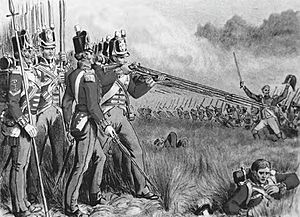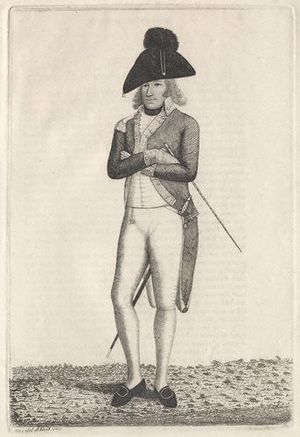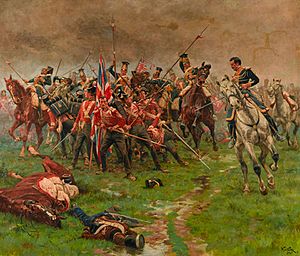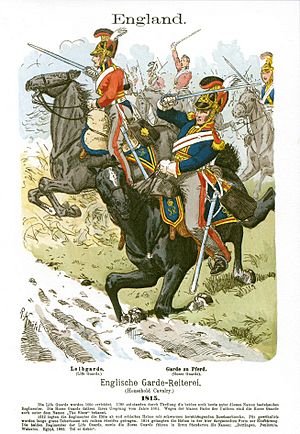British Army during the Napoleonic Wars facts for kids
The British Army during the Napoleonic Wars was a time of big changes for Britain's soldiers. In 1793, when the French Revolutionary Wars began, the army was quite small, with only about 40,000 men. But by 1813, at its strongest, the army had grown to over 250,000 soldiers! The British infantry (foot soldiers) were known for being very strong and never suffered a major defeat against Napoleon's France.
Contents
How the Army Was Set Up
In 1793, the British Army had different types of soldiers. There were three regiments of Household Cavalry (soldiers who rode horses and protected the royal family). There were also 27 other cavalry regiments and seven battalions of Foot Guards (special infantry units). The main part of the army was 81 battalions of line infantry. A battalion is a large group of soldiers, usually around 1,000.
The Board of Ordnance managed the artillery (cannons and big guns) separately. They had many companies of foot artillery and horse artillery. The Royal Engineers were special officers who built things like bridges and forts.
At first, there wasn't a clear way to command the whole army. Different government groups controlled units depending on where they were. But in 1793, they started to organize things better by appointing generals to lead military areas in England and Wales.
How Soldiers Joined the Army
The British Army got most of its new soldiers from the poorer parts of society. Life in the army was tough, and pay was low. So, it mainly attracted people who had a harder life outside the army. Even the Duke of Wellington said that many joined because of problems like debt or trouble with the law.
Most soldiers signed up for life, getting a "bounty" (a payment) of about £23. But in 1806, they started a "limited service" system. This meant soldiers could sign up for a set number of years (7 for infantry, 10 for cavalry). This helped attract more people. From 1800, soldiers also got a daily "beer money" allowance. The army also made some changes to discipline, reducing harsh punishments for small mistakes. Unlike other armies in Europe, Britain did not force people to join (conscription); joining was always voluntary.
During long wars, battalions often had fewer soldiers than they should. Many soldiers died or were discharged because of wounds or sickness. For example, in the Peninsular War, almost 25,000 men were lost to wounds and disease, while fewer than 9,000 died directly in battles.
Officers (leaders) came from different backgrounds. They needed to be able to read and write. While many officers bought their positions, this system was relaxed during the wars. This meant more officers could rise through the ranks based on their skills, not just their wealth. The Duke of York made sure officers had to serve for a certain number of years before getting promoted, which helped improve their experience.
Infantry (Foot Soldiers)

The infantry was the main part of the army. There were three regiments of Foot Guards, which were elite units. They got better training and pay.
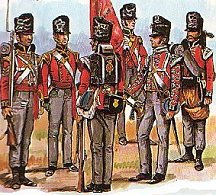
Eventually, there were 104 regiments of the line infantry. These regiments were numbered and often named after areas in Britain, but soldiers from all over Britain served in most of them. Most regiments had two battalions, each usually led by a colonel or lieutenant colonel. A battalion had ten companies, including special "flank" companies like grenadiers and light infantry (skirmishers).
Ideally, a battalion had 1000 men, but in battle, numbers would drop. The 1st battalion of a regiment would often get new recruits from the 2nd battalion to stay strong.
Infantry Tactics
After the American War of Independence, the British infantry started using more rigid, close-order formations. Their main tactic was the "line formation." This formation allowed all soldiers to fire their muskets at the enemy at the same time, creating a huge amount of firepower. While French armies often used column formations, the British line was very effective because more muskets could fire at once.
British soldiers were also very well trained in shooting their muskets. They practiced much more than soldiers in other European armies. Their standard weapon was the "India Pattern" version of the Brown Bess musket. It was accurate up to about 100 yards, but soldiers often waited until the enemy was much closer, around 50 yards, before firing.
Riflemen and Light Infantry
The British Army also developed special light infantry units. These soldiers were more flexible and could fight in looser formations. The first unit armed with rifles, the Baker rifle, was formed in 1800. This unit became the famous 95th Regiment of Foot (Rifles). Rifles were more accurate than muskets and were very useful in hilly areas, like during the Peninsular War.
In 1803, Sir John Moore trained two regiments to be light infantry at Shorncliffe Camp. This training encouraged soldiers to think for themselves and be more self-reliant. Light infantry and rifle units wore different uniforms. Rifle units wore dark green uniforms, while other light infantry wore red jackets without tails.
Uniforms
The standard uniform for most British soldiers was the traditional red coat. There wasn't one main supplier for uniforms, so each regiment often got its own, leading to small differences. Highland regiments wore kilts and tall ostrich feather hats.
Over time, the hats changed. The bicorne hat was replaced by a cylindrical cap, and then by the "Belgic" cap in 1812. Grenadiers and Foot Guards still wore bearskin hats, but not during campaigns.
In 1802, chevrons (V-shaped stripes) were first used to show the rank of sergeants and corporals. This made it easy to tell them apart from regular soldiers.
Officers paid for their own uniforms, so their styles varied. They often wore scarlet coats and white trousers. Generals and field officers usually wore bicorne hats, while company officers often wore the same headgear as their men during campaigns. Officers carried swords, with light infantry officers often using a sabre (a curved sword).
Colours (Flags)
Most British battalions carried two flags, called "colours." The First, or "King's Colour," had the Union Flag (the British flag) with the regiment's number. The Second, or "Regimental Colour," was the colour of the regiment's uniform facings (collar and cuffs), with a small Union Flag in the corner.
These flags were carried into battle to help identify units and as a rallying point for soldiers. Carrying the colours was very dangerous because they were a target for the enemy. Losing the colours was a great dishonor, so soldiers fought hard to protect them. Light infantry units sometimes didn't carry colours because they fought in spread-out formations.
Medals
Campaign medals became common during the Napoleonic Wars. The Army Gold Medal was given to commanders for important battles in the Peninsular War. After the Battle of Waterloo, a special Waterloo Medal was given to all soldiers who fought there. Years later, the Military General Service Medal was awarded to all ranks for service in campaigns between 1793 and 1814.
Cavalry (Horse Soldiers)
At the start of the wars, "heavy" cavalry units included the Household Cavalry, Dragoon Guards, and Dragoons. They wore red uniforms and bicorne hats. From 1796, they used a heavy, straight sword.
"Light cavalry" units were called Light Dragoons. They were used for scouting and patrolling. They wore short blue jackets and a leather Tarleton helmet. They carried a curved sabre, good for cutting.
In 1806, some light dragoon regiments became Hussars, known for their fancy uniforms. From 1812, many British cavalry uniforms changed to look more like French styles, which sometimes made it hard to tell them apart on the battlefield.
British cavalry horses were excellent, and British cavalrymen were often better in small clashes than French cavalry. However, they were not always well-trained for large-scale battles. The Duke of Wellington often complained about the quality of his cavalry officers.
Campaigns (Battles and Wars)
The British Army fought in many places during the French Revolutionary and Napoleonic Wars, with short breaks in between.
French Revolutionary Wars (1793-1802)
India (Mysore), 1789–1792 and 1798–1799
The British Army fought two major wars in India against the Kingdom of Mysore, led by Tipu Sultan. British soldiers formed the core of the East India Company's army. They captured the Mysorean capital, Seringapatam, and won both wars, which helped Britain control more of India.
Toulon, 1793
In 1793, British troops helped defend the French city of Toulon against French Republican forces. The British commander was captured by a young Napoleon Bonaparte. The British and their allies eventually had to leave the city.
Flanders (Netherlands), 1793–1796
A British army, along with allies, fought against the French in the Netherlands. They had some early wins but were eventually forced to retreat in harsh winter conditions. This campaign showed that the British army needed to improve its discipline and supplies.
West Indies, 1793–1798
Britain also fought in the West Indies to protect its trade. This campaign was very tough because of diseases like yellow fever. Out of 89,000 British soldiers, over 43,000 died from disease. Many islands were captured, but the British lost a huge number of men.
Ireland, 1798
A rebellion broke out in Ireland, supported by a secret society. The British Army, along with local militias, fought to put down the rebellion. A French force landed in Ireland to help the rebels but was eventually defeated.
Egypt, 1801
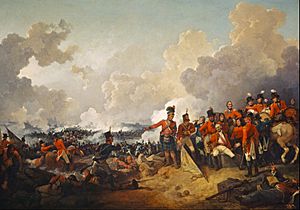
Napoleon had invaded Egypt in 1798. Britain sent an expedition to remove the French. After a successful landing, British forces won the Battle of Alexandria (1801). This victory showed how effective British musketry and discipline had become. The French were forced to leave Egypt.
Napoleonic Wars (1803-1815)
India (Maratha), 1803–1805
The British East India Company fought another war in India, this time against the Maratha Empire. British regiments helped win important battles like Assaye, leading to another British victory.
West Indies, 1804–1810
When war with France started again, Britain attacked French islands in the West Indies once more. French forces there were weak from disease. Britain captured several islands, including Martinique and Guadeloupe.
South Africa and South America, 1806–1807
British troops captured the Dutch colony at the Cape of Good Hope in South Africa, which was an important stop for ships going to India. Later, a British force tried to capture Spanish colonies in South America, like Buenos Aires. They succeeded for a short time but were then forced out. A second invasion also failed, and the British commander was removed from his post.
Denmark, 1807
In 1807, a British force went to Copenhagen to seize the Danish fleet. They wanted to stop it from falling into French hands. After a short fight and bombardment, the Danes surrendered their fleet.
Walcheren, 1809
Britain sent a large force to the island of Walcheren in the Netherlands. The goal was to capture Dutch ports. However, the mission was delayed, and many soldiers became sick with malaria. More than a third of the army died or became too ill to fight before they were pulled out.
Peninsular War (Spain and Portugal), 1808–1814
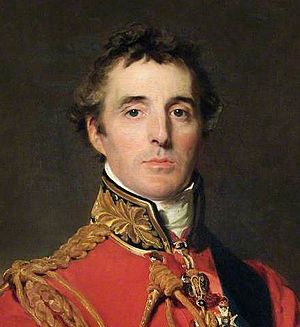
In 1808, Napoleon took over Spain and Portugal. Sir Arthur Wellesley (who later became the Duke of Wellington) led a British army to Portugal. He won the Battle of Vimeiro. After some changes in command, Sir John Moore led the army into Spain. They had to retreat in a harsh winter, fighting the French all the way to Corunna, where Moore was killed.
In 1809, Wellington returned to Portugal. He drove the French out of Portugal and built strong defensive lines called the Lines of Torres Vedras to protect Lisbon. He reorganized his army, which included both British and Portuguese soldiers.
The next year, a large French army invaded Portugal, but Wellington's defenses held strong. For the next few years, Wellington fought many battles to regain fortified towns. He won important victories at Salamanca in 1812.
In 1813, Wellington pushed into northern Spain. At the Battle of Vitoria, the French armies were completely defeated. Wellington's troops then crossed into France, winning more battles like the Battle of Nivelle and Battle of Orthez. Their discipline was much better than other armies, thanks to good supplies.
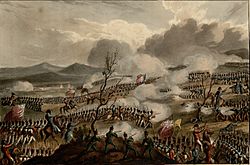
In March 1814, allied armies entered Paris, and Napoleon gave up his power. The British army then left Spain and France.
War in North America (War of 1812)
While the Napoleonic Wars were happening, Britain also fought the War of 1812 against the United States. British regular units, along with Canadian militias, defended Canada against American invasions. In 1814, after Napoleon's defeat, more British soldiers arrived. A British force captured and burned Washington, D.C., but was stopped at Baltimore. The war ended with a peace treaty, but before the news reached America, a British force was defeated at the Battle of New Orleans.
Waterloo Campaign, 1815
In 1815, Napoleon escaped from exile and quickly raised a new army in France. The Allies formed new armies to stop him.
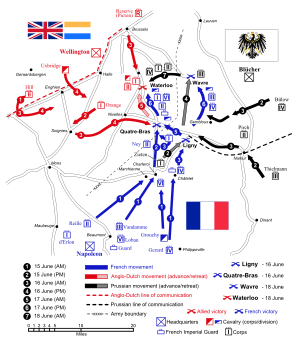
The Duke of Wellington commanded the British and allied forces in Belgium, while the Prussians were led by Gebhard Leberecht von Blücher. Napoleon attacked them separately. On June 16, 1815, Napoleon fought the Prussians at Ligny, while his general, Marshall Ney, attacked Wellington's army at the Battle of Quatre Bras. Wellington held his ground, but the Prussians had to retreat.
On June 18, 1815, the famous Battle of Waterloo began. Wellington's army was on higher ground south of Waterloo. The French started with an artillery attack. British and allied troops bravely defended key positions like the Chateau of Hougomont all day. The French infantry attacked the British left wing but were pushed back. Later, French cavalry charged, but the British soldiers formed strong infantry squares (hollow box shapes) that the cavalry could not break.
The battle was very close, but then the Prussians started to arrive, helping Wellington. Around seven o'clock, Napoleon sent his best soldiers, the Old and Middle Guard, in a final desperate attack. But this attack was also pushed back. At that moment, Wellington signaled a general advance, and his army charged forward, defeating Napoleon's forces. Napoleon lost the battle, ending his rule.
What Happened Next
After the wars, the British Army became much smaller. Many regiments were disbanded. By 1821, the army had only about 101,000 soldiers, with many stationed in colonies like India. Over the next decades, the army changed to meet new needs, but it didn't become very large again until the First World War.
|


